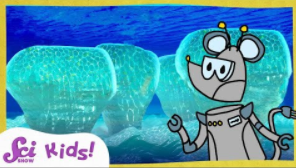Whoa, Squeaks, what are you building?
哇,吱吱,你在建什么?
That’s so cool!
太酷了!
I love dinosaurs, and pretending to visit them in a time machine sounds like so much fun.
我喜欢恐龙,假装坐时光机去看它们感觉很有趣。

Your time machine is going to have to go back in time really far to see dinosaurs.
你的时光机必须回到非常遥远的过去才能看到恐龙。
Dinosaurs lived on Earth a long time before there were any people, so we don’t have any photos, or videos, or stories from people.
恐龙在人类出现之前就在地球上生活了很久,所以我们没有任何人类的照片、视频或故事。
Because no one ever saw dinosaurs themselves!
因为没人亲眼见过恐龙!
Everything we know about dinosaurs, and the way the world was when they lived here, comes from special clues that were left behind and lasted until people could discover them and try to understand what those clues meant.
我们所知道的关于恐龙的一切,以及它们生活在这里时的世界方式,都来自于特殊的线索,这些线索被遗留下来,一直持续到人们可以发现它们,并试图理解这些线索的含义。
Fossils are a great example of a clue, Squeaks!
化石是一个很好的线索,吱吱!
Fossils are created over many years from leftover bones and other things from animals long ago, like dinosaurs.
化石是很久以前由恐龙等动物遗留下来的骨头和其他东西经过多年形成的。
Fossils can form from things like bones, shells, or even footprints!
化石可以由骨头、贝壳甚至脚印之类的东西形成!
It’s so fun to take clues like fossils, and try to figure out what life on Earth was like before humans were around.
寻找像化石这样的线索,并试图弄清楚地球上的生命在人类出现之前是什么样子,这是非常有趣的。
That’s a really good question.
这是个很好的问题。
Squeaks wants to know, “If dinosaurs lived before people, did anything live before dinosaurs?”
吱吱想知道,“如果恐龙生活在人类之前,那么有什么东西存在于恐龙之前吗?”
How about we use your time machine to explore the first known living thing on Earth.
不如我们用你们的时光机去探索地球上第一个已知的生物吧。
Let’s start our pretend journey back in time.
让我们开始虚幻的时光倒流之旅吧。
I’m setting it to send us back 3.5 billion years ago, way before people or even dinosaurs.
我设定它让我们回到35亿年前,远远早于人类甚至恐龙时期。
That’s so long ago, it’s almost as far back as our time machine could take us in all of Earth’s history!
那是很久以前的事了,这几乎是我们的时间机器在地球历史上能带我们走的最远的时间了!
Ready, let’s go!
准备好了,我们出发!
Whoa, I think we made it!
哇,我想我们成功了!
Ready to see a clue from the first living thing on Earth?
准备好从地球上第一个生物那里寻找线索吗?
This is a stromatolite.
这是叠层石。
It does look like a rock, because it is one.
它看起来确实像一块石头,因为它就是一块。
Stromatolites are special rocks made by cyanobacteria, the first known living things on Earth.
叠层石是由蓝细菌制成的特殊岩石,蓝细菌是地球上已知最早的生物。
When you look at a stromatolite, you’re looking at the home of lots of teeny, tiny living things called cyanobacteria.
当你看叠层石的时候,你看到的是许多微小的叫做蓝细菌的生物的家园。
They’re so small, you can fit thousands and thousands of them in a stromatolite.
它们是如此之小,你可以在叠层石中容纳成千上万的它们。
There are probably more bacteria in a stromatolite than there are people in the biggest city you can imagine!
叠层石中的细菌可能比你能想象的最大城市里的人还多!
Stromatolite fossils are the oldest fossils anyone has found.
叠层石化石是人们发现的最古老的化石。
They’re the first clues about early life on Earth.
它们是关于地球早期生命的第一条线索。
We find them in places that had shallow, salty water, like near the ocean!
我们在有浅浅的咸水的地方发现它们,比如靠近海洋的地方!
Good question! The cyanobacteria actually made the stromatolites themselves, over a long, long time.
问得好!蓝细菌实际上在很长很长一段时间内自己制造了叠层石。
Cyanobacteria live in water, and they make their food like plants do.
蓝细菌生活在水中,它们像植物一样制造食物。
They gather nutrients around them and energy from sunlight, and they put those nutrients together in a process called photosynthesis.
它们在周围收集营养物质和来自阳光的能量,然后把这些营养物质放在一起,形成一个叫做光合作用的过程。
As cyanobacteria sit in the water and make their food through photosynthesis, they also make a bit of rock called limestone.
当蓝细菌栖息在水中,通过光合作用制造食物时,它们还会产生一种名为石灰石的岩石。
A whole bunch of cyanobacteria in one place looks like a mat, and the limestone the bacteria make gets stuck together with other pieces of rock that wash up onto the mat.
一大堆蓝细菌在一个地方看起来就像一个垫子,细菌产生的石灰石与其他被冲上垫子的岩石粘在一起。
As the cyanobacteria keep growing up towards the sunlight, the old pieces of rock form a layer, and then another layer, and then another.
随着蓝细菌不断朝着阳光生长,古老的岩石块形成了一层,然后是另一层,然后又是另一层。
Kind of like they are making a lasagna for their home!
有点像他们在为自己的家做千层面!
We call all of those rock layers together a stromatolite.
我们称所有这些岩层为叠层石。
Yeah, that stromatolite fossil has some really impressive layers.
是的,叠层石化石有一些令人印象深刻的层级。
Those layers take an extremely long time to form, much longer than it takes a person to grow up, so scientists have to use special tools to help them tell the age of the different stromatolite layers.
这些叠层的形成需要极长的时间,比一个人成长的时间要长得多,所以科学家们必须使用特殊的工具来帮助他们分辨不同叠层石层的年龄。
And by figuring out the age of stromatolites, scientists can tell that cyanobacteria were some of the first living things on Earth!
通过计算叠层石的年龄,科学家可以断定蓝细菌是地球上最早的生物之一!
Yes, even before the dinosaurs.
是的,甚至在恐龙之前。
In fact, dinosaurs are much closer in time to us than they are to stromatolites!
事实上,与恐龙离叠层石出现的时间相比,恐龙在时间上离我们更近!
Stromatolites are super, super, super old!
叠层石是超级,超级,超级古老的!
What’s truly amazing is that we still have living stromatolites here on Earth today!
真正令人惊叹的是,我们今天在地球上仍然有活着的叠层石!
Cyanobacteria still live on Earth, and in places like Shark Bay, Australia, you can actually go see a living stromatolite!
蓝细菌仍然生活在地球上,在澳大利亚的鲨鱼湾这样的地方,你可以真正看到活的叠层石!
Scientists seek out living stromatolites to study them.
科学家们寻找活的叠层石来研究它们。
That way, they can understand what the Earth might have looked like when cyanobacteria were the only things living on Earth.
这样,他们就可以了解当蓝细菌是地球上唯一的生物时,地球可能是什么样子。
Oh wow, Shark Bay is like a time machine.
哦,哇,鲨鱼湾就像一台时光机。
The stromatolites there help us to imagine life long ago.
那里的叠层石帮助我们想象很久以前的生活。
Life has changed so much since then, so we’re really lucky to have stromatolites to learn from even today.
从那时起,生活发生了很大的变化,所以我们真的很幸运,即使在今天,我们也有叠层石可以学习。
I think learning more about Shark Bay sounds like a fun time, too!
我认为更了解鲨鱼湾听起来也是一件很有趣的事情!
Maybe it would give us ideas about what time period to visit next in your time machine.
也许它会让我们知道你们的时光机下一次访问的时间段是什么。
Can you imagine what the Earth might have been like when cyanobacteria first lived?
你能想象当蓝细菌首次出现时地球可能会是什么样子吗?
What time periods do you want to learn more about?
您想了解更多关于哪些时间段的信息?
If you want to keep exploring through time with me, Squeaks, and all of our friends, make sure to hit the subscribe button below.
如果你想继续与我、吱吱和我们所有的朋友一起通过时光探索,请务必点击下面的订阅按钮。
We’ll see you next time, here at the Fort.
我们下次见,在福特堡这里等你。











